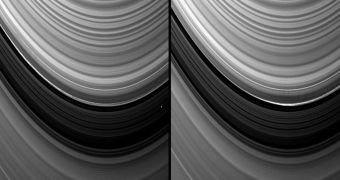Astronomers have recently discovered the the motion and behavior exhibited by Saturn's rings could be very similar to the same traits displayed by the entire spiral arm of a galaxy.
In other words, it could be that the same physical principle underlie the action of both bodies, which is an amazing finding, because studying spiral arm physics is really difficult.
Furthermore, we now have an orbiter around the gas giant. The NASA Cassini spacecraft has been revolving around the planet since July 2004, and it has thus far provided vast amounts of photographic material to cover the rings.
If the same studies were to be carried out on galactic spiral arms, then researchers would have to look at the Andromeda galaxy, or other such structures, even further away.
This is a lot more difficult to do than simply browsing through some high-resolution images of Saturn's rings, experts involved in the research say.
Scientists first determined that the rings have potential for this kind of research when they discovered the peculiar oscillations that affect the Saturn's massive B Ring.
It was determined that the motion were not caused by interactions the ring may have had with a Saturnine moon, or with the planet itself, which meant that another kind of physics had to be at work.
After careful studies, the experts realized that the ring has sufficient density to allow for unforced “free” waves to self-develop. This was made easy by the fact that the ring's edges are very sharp.
This type of physical reaction to a shape is very common in disk systems in general, say astronomers, which means that any findings that are made around Saturn can be translated in planetary disks and galactic spiral arms.
“We have found what we hoped we'd find when we set out on this journey with Cassini nearly 13 years ago: visibility into the mechanisms that have sculpted not only Saturn's rings, but celestial disks of a far grander scale, from solar systems, like our own, all the way to the giant spiral galaxies,” explains researcher Carolyn Porco.
She holds an appointment with the Cassini imaging team, and at the Space Science Institute in Boulder, Space reports.
The expert is also the co-author of a new paper detailing the findings, which appears in the November 1 online issue of the the Astrophysical Journal.
“These oscillations exist for the same reason that guitar strings have natural modes of oscillation, which can be excited when plucked or otherwise disturbed,” adds researcher Joseph Spitale.
“The ring, too, has its own natural oscillation frequencies, and that's what we're observing,” explains the SSI scientist, who is also the lead author of the new paper.

 14 DAY TRIAL //
14 DAY TRIAL //